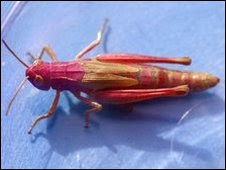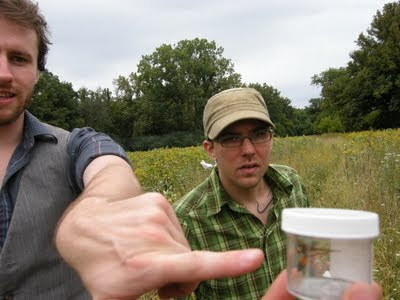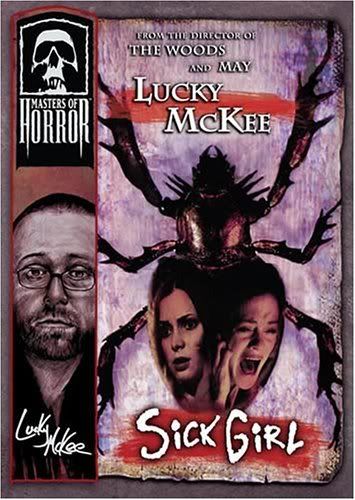- Ji Soo
Wednesday, December 16, 2009
Crazy fungi thing that shoots out of the brain of insects!
- Ji Soo
Law and Order: Entomology

PBS: Nature has a good documentary on how insects help with forensics called Crime Scene Creatures it's a little cheesy but still fascinating
Tuesday, December 15, 2009
Saturday, December 12, 2009
evolution by hybridogenesis theory debunked and a hermaphrodite moth

Friday, December 11, 2009
Metamorphosis and a Brain Hormone

"In its overall design, insect metamorphosis is very much like passage through puberty," O'Connor says. "From a biological point of view, both puberty and metamorphosis accomplish the same goal -- to provide reproductive capacity for the species at the appropriate developmental time." The brain hormone becomes active when insects have reached a threshold body weight, which is also a trigger for human puberty.
http://www.sciencedaily.com/releases/2009/03/090331201522.htm
- w
Thursday, December 10, 2009
Let's talk about fruit flies baby, let's talk about you and me

So, I have been on a bit of binge of sordid fruit fly sex research today. There are so many interesting articles being written about the role that genetics play in mate selection, sexual orientation, and the desire to settle down and have a family. Here are three articles I have found especially arousing-(scientifically speaking).
Wednesday, December 9, 2009
Cricket lollypop
Bug art

Beginning in 1977, a well-known San Francisco Area restauranteer, and character, named Juanita Musson, operated a bar and restaurant , ( The Warehouse Cafe) located below "Dr. Gladstone's Wonders of the World Museum" in downtown Port Costa. As a joke on Juanita, Clayton Bailey made several large ceramic Bugs to hang on the walls and ceilings of his Wonders Museum claiming that the bugs came upstairs from Juanita's restaurant.
http://www.claytonbailey.com/bug.htm
-w
Bed bugs
http://www.youtube.com/watch?v=4qx751dNw7Q&feature=player_embedded
-w
Tuesday, December 1, 2009
Insect Pheromones Used As Insecticides
Friday, November 20, 2009
The insects of Birmingham






Monday, November 16, 2009
Ugly Bugs ... but really, who are we to say?

A short blurb on the Scientific America site describes Arizona State University and Northern Arizona University's second annual 'ugly bug contest.' The voting is open to the public. The contest is conducted by offering lush microscopic photographs and short behavioral profiles on each contestant. Even though the contest designers do not address the subjective nature of ugliness, it is still pretty fun.
Here is the Scientific America blurb
And here is the actual contest
Sunday, November 15, 2009
drawing on insects

For the scientific illustration and biological wall chart aficionados out there, I thought I would point out a nice resource for some excellent entomological images: The Lueckhart Charts, found that the Marine Biological Lab website.
AY
"Field" trip!
 A short trip to the Field Museum of Natural History last week brought our class up-close-and-personal with the 4 million pinned (and 8 million wet) specimens they have. Jim Boone showed us around the collections, while Corrie Moreau gave us a excellent tour of the molecular phylogenetics facility and told us all about her work on ant evolution.
A short trip to the Field Museum of Natural History last week brought our class up-close-and-personal with the 4 million pinned (and 8 million wet) specimens they have. Jim Boone showed us around the collections, while Corrie Moreau gave us a excellent tour of the molecular phylogenetics facility and told us all about her work on ant evolution. To round everything out, scientific illustrator and watercolor artists Peggy MacNamara showed us some of her current work in her in situ museum studio. We looked at originals from her book Illinois Insects & Spiders as well as some from a couple forthcoming books as well. All around, quite a nice "Field Trip" (sorry, couldn't help it!)
AY
Friday, November 13, 2009
"Babes or bugs: you can't have both!"
So I just watched the movie Sick Girl from Showtime's Masters of Horror anthology, and I found more than a few problems with it. For those not in the know, the series features one-hour films by "the foremost filmmakers of fright." In this particular episode, a lebian entomologist, her dream girl, and a South American parasitic mystery bug named Mick fall in love. All of them. And in the great tradition of pseudo-scientific monster flicks like Mimic, The Fly, and Species, it’s ridiculous.
The film conflates spiders, millipedes, snails and insects, which are all vastly disparate denizens of the animal kingdom: in one scene two spiders and two dragonflies are pinned to a board of beetles. If we're going to accept that “bug” is an acceptable overarching term in the first place – it’s not – the screenwriter should at least know the difference between arthropods and mollusks. We also find out that the word "proboscis" is applicable to anything extend-y (which leads to a charming penis joke) regardless of position in body plan and function. These scientists are haplessly uninformed and strangely unwilling to accept the possibility of a new species. “An insect that hunts and kills mammals? Come on, there's no such thing!” an entomologist scoffs at one point, despite the fact that the specimen is the size of a dinner plate. This “bug,” cutely dubbed Mick, is vaguely arachnid and vaguely mantid, with sucking mouth parts and non-functional wings, if they exist at all. The fact that the researchers couldn't determine the sex of an unknown species was taken as a point of spookiness, whereas in biology hermaphroditic, asexual and even intersexed species or individuals are rampant. The real question - whether it has six legs or not - is evaded by the use of quick camera work and cheesy effects.
Not only is the film uninformed, it perpetuates the stereotype of entomologists - in particular female entomologists - as socially-deficient weirdos, a trope emphasized by the protagonist's "deviant" sexual preference for other women. This makes sense in terms of director Lucky McKee's other work (in particular, 2002's May, another weirdo-romance story also featuring Angela Bettis), but in this case her undesirability is directly related to her enthusiasm for bugs: she's the ick-equivalent of the crazy cat lady, baby-voicing the tarantulas that are perpetually crawling all over her while the audience takes its cue to squirm. While cutesy and sympathetic, the placement of this story under the auspices of horror cements the “extreme” status of both “bugs and babes.”
Some other gems o’ skewed-logic that we can glean from Sick Girl:
- Brazil is a place where wondrous demon bugs roam wild, because it's tropical and stuff
- The irresistable urge to add screechy sounds and mucus to everything vaguely monstrous/unknown is never wrong, regardless of the biology you’re ripping off
- Pencil drawings of faeries make for good art
- Lesbians are always hot
It’s hard to say whether this story is to be taken as an individual case or a symptom of general attitudes towards "bugs," those who study them, and alternative sexualities. Maybe it's just a stupid horror movie.
At least the soundtrack was decent.
posted by Anne Chino
Thursday, November 12, 2009
Scientists find a population of diverging butterflies
Scientists have recently discovered a population of Heliconius butterflies that have begun to show the process of divergent evolution. The Heliconius have color-based mating preference, and the two colors within the population are beginning to mate exclusively with their own color, despite their genetic likeness. Read the article at http://www.utexas.edu/news/2009/11/05/butterflies_species/
posted by Joe Song
Monday, November 9, 2009
why for art thou colorful male?
 ____
____A week or so ago in class the question came up as to why males are not only so colorful relative to females, but why across species the colors and patterns vary so much.
Research reported on this week points to one possible answer: To avoid INTERspecies male-male competition!
In a variation on sexual selection theory we see coloration as not only a means to attract mates of the came species, but perhaps also avoid conflict with those of other species you happen to cohabit with.
This work has found observational support in damselflies, and the question is to how many other species it may apply.
To see a little about the research, go here.
AY
Friday, November 6, 2009
Thursday, November 5, 2009
Friday, October 30, 2009
Mutant Insects, Oh My!


We pee, but do they?
Thursday, October 29, 2009
Tuesday, October 27, 2009
Tiny ears found on butterfly’s wings

"A butterfly species equipped with tiny ears on its wings can distinguish between high and low pitch sounds, possibly as a way to listen in on nearby birds, new research suggests."
http://www.msnbc.msn.com/id/33483193/ns/technology_and_science-science/
Saturday, October 24, 2009
Serial Killers & Bees
Informative, Disgusting, and above all a reason to get married
Tuesday, October 20, 2009
Nice Pictures
Thursday, October 15, 2009
Green Porno: Insects at It
Ah, the praying mantis. Of course we know better than to assume the head is always bitten off the hapless male (for the essay, click here). Still, it is an amazing feature of their life, een if not so common
And then, the bees. We haven't delved much yet in to the world of social insects, but this is a nice intro and refers to the odd ends males will go to in securing their paternity (another gruesome death included)
And check out the rest of organisms in the Green Porno features as well!
AY
Wednesday, October 14, 2009
Fly ruins "fly guy"
 ____
____fyi fly:
"A pesky insect may be partly to blame for an Air Force colonel losing his job today."
A missile wing commander at North Dakota's Minot Air Force Base was relieved of command for a loss of confidence in his command abilities following a series of recent incidents that included the rollover of a semi-trailer carrying missile parts, an accident caused when the driver tried to swat away a large insect that had landed on his back"
water bug scramble

I was at the store yesterday and came across a interesting food item in the frozen section...giant water bugs.
Yep! The Golden Pacific Market was selling these lovelies for $3.28 for a pak of four. The Filipino checkout lady said to smother them in chili paste, the stock boy (Thai) said instead to grill them, crush them, and mix them in scrambled eggs)
I don't know where these bugs came from (could be North American) as there was no sort of label on them. Still, I think I'm going to try the scrambled egg option....
AY
Monday, October 12, 2009
the evolutions of gliding flight

As We've been discussing the "Gliding Hypothesis" for the origination for insect flight, including gliding ants, it seemed only right to mention "Birdmen."
And what are they? Much like a flying squirrel, these folks have membranes they use to glide, and at VERY high speed - rather than of of trees, off of mountain tops (pictured below).
60 Minutes recently did an extensive video segment on them, which is worth watching. I don't use the word "crazy" very often, but this might fall under that category. Beautiful, amazing, crazy.


Saturday, October 10, 2009
biodiversity sampling - a windshield away!

Mabe you don't even need a whole orgnanism to do good biodiverstiy sampling?
This is what researchers analysing windshield and bumper splats on cars are considering as they posit the possiblity that the organisms that cars hit on roadtrips may provide an ecological sample of the kind and abundance of organisms in an area.
This paper is more about proof-of-concpet that concerned with insects per se, but they did find that Flies and Bugs were the vsat majority of what the cars caught, and that indded, differnces in fuana could be detected on cars taking differnt routes... a start (albeit grisly) to another avenue of research....
Tuesday, October 6, 2009
mm, that is some good "land shrimp"

I opened my iGoogle page today, which has various web sites feeding into it daily.
One such feed I have is WikiHow, where two How To's appear. And what were they today?

Grasshoppers!
It makes a point to say:
"Also note that if you eat crawfish or clams (i.e. worms in shells), this isn't really much different."
Unfortunately, the accompanying video is less-than-amazing, perhaps they need Martha Stewart on this beat.
Here is the link to the WikiHow page.
And of course, a link to the Small Stock/Land shrimp project of David Gracer.
AY
Monday, October 5, 2009
New Metamorphosis Theory

Sunday, October 4, 2009
more finds near O'Hare....

Another trip to Chevalier Woods on a much sunnier day found us among many more butterflies and dragonflies than the week before, and even a cicada! Here is one in a jam (in a jam jar).

And just a couple other moments caught:
Daniel got a nice Odonate here...

Meanwhile, I spied some moths-a-mating. I used to mate Eastern Black Swallowtails by hand for research purposes - better & easier if you can leave them to it.

This milkweed bug had dressed gotten rid of its old clothes in a molt and was looking very pink as it waited quietly for its exoskeleton to harden up again

Andrea managed to net a beautiful monarch, handling it expertly,

And this time too, some cute little snakes here and there...

Thursday, October 1, 2009
Tuesday, September 29, 2009
Saturday, September 26, 2009
Pink Grasshopper!

Pink grasshopper found in marshes
I saw this article a few weeks ago and thought it was interesting. (And pretty!)
Monday, September 21, 2009
Chevalier Woods (hunting Big-Small Game)

Chevalier Woods is always the place to find a Praying mantis (Chinese or European) in Chicago, and this year is no exception to the rule. A.C. found a lovely one and talked things through a little bit - eyes to eyes - before finally (and somewhat sadly) putting him in a jar...

Large Carpenter Bees where also around and about. With those big eyes, they see you coming. This ones was particularly calm.

Or course, other wildlife abounded as well: from slugs, spiders, and mice to these cute snakes resting underneath pieces of wood.

Under the same piece of wood of the snake was a large ant colony, understandably all hither-tither over the fact we disturbed them, and moving their brood to safety.

J. caught a remarkable looking wasp with a right-orange abdomen.

all together - let's go!

Little juveniles abound on this milkweed....

And though butterflies were few this time, a couple still stood out
A little video of J's waspy find.












